The Rise of Artistic Woodturning
A craft reborn in war and social upheaval
by Kevin Wallace
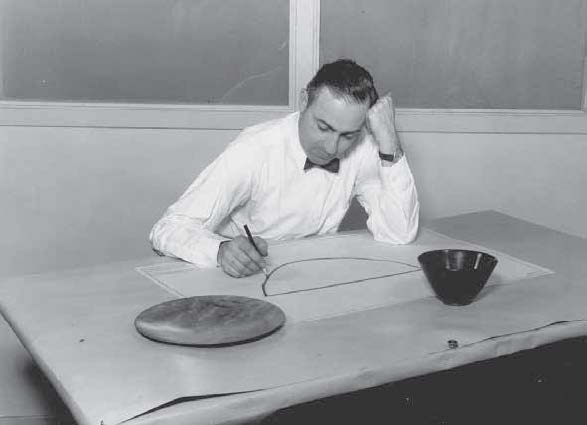 |
1940s: James Prestini’s wooden bowls first established woodturning as a serious artistic endeavor.
|
| |
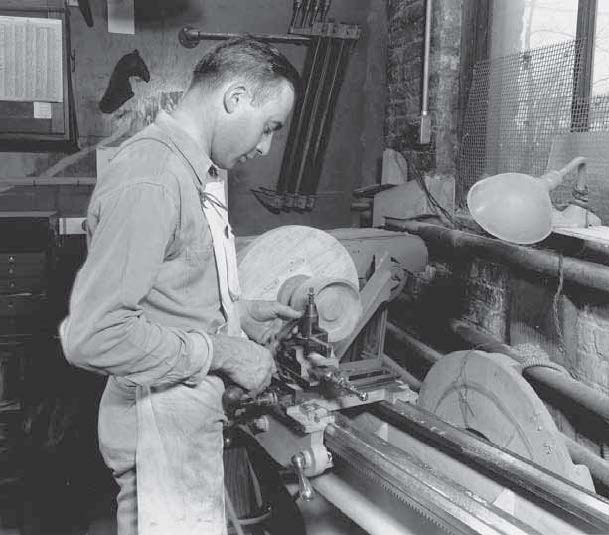 |
1940s: Prestini worked with a metal lathe. Its gear-driven tool post gave him mechanical control of the forms he created.
|
| |
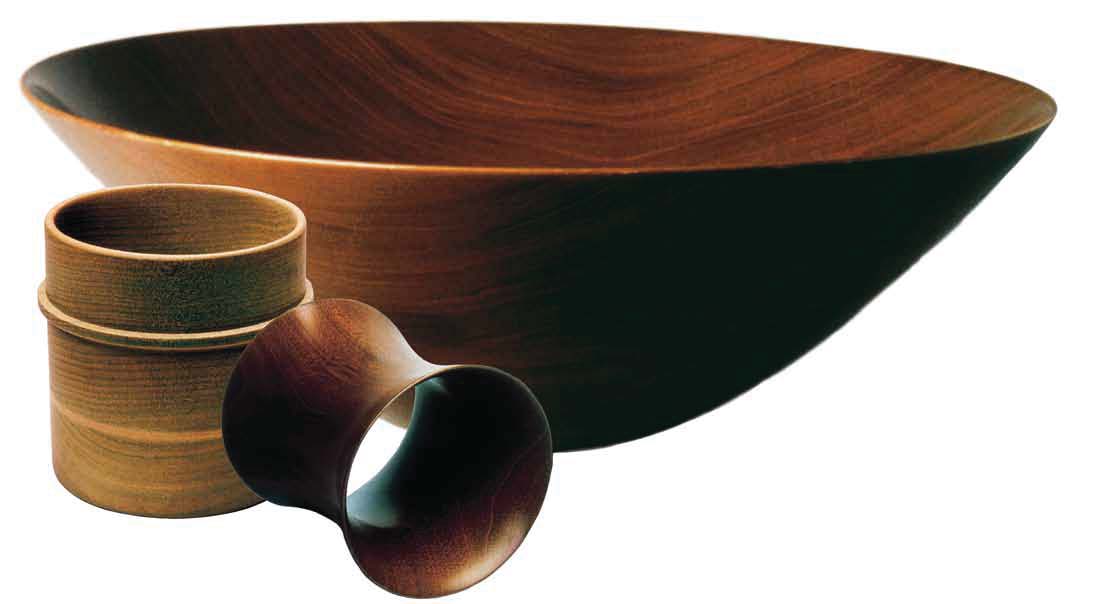 |
1948: Thin and light turned wooden bowls by James Prestini.
|
| |
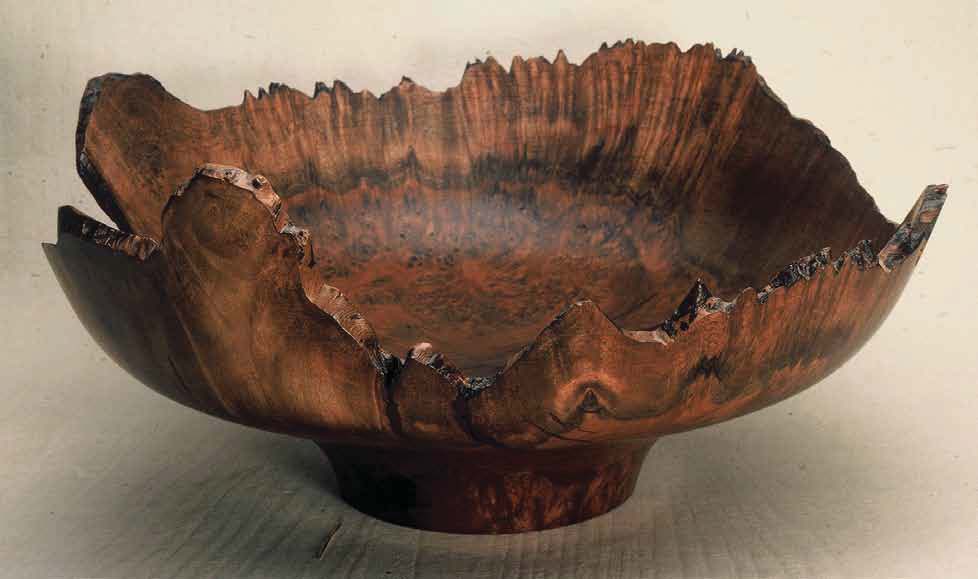 |
1970s: Natural edge bowl by Bob Stocksdale, walnut burl, 13" diameter.
|
| |
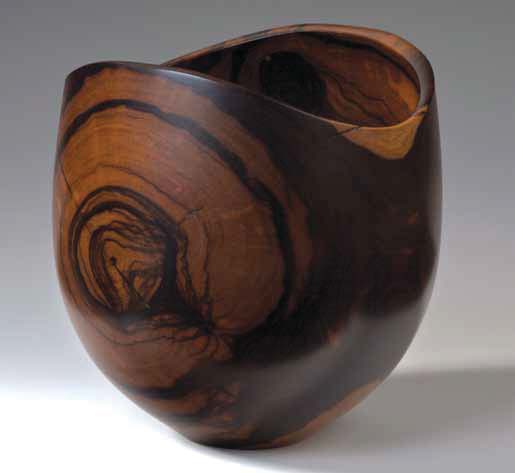 |
Like Prestini, Stocksdale was renowned for his ability to turn bowls
with coin-thin walls, the inside perfectly echoing the outside.
|
| |
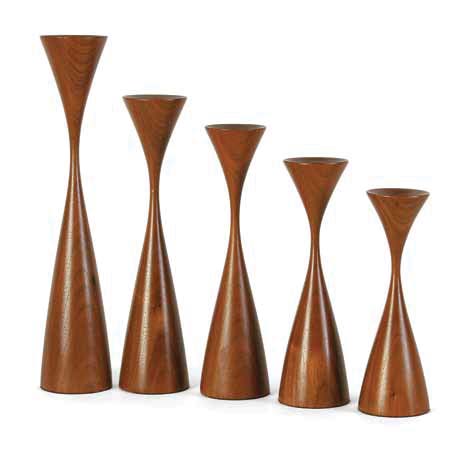 |
1960s: Along with his gifts as a teacher, Rude Osolnik was a tireless
innovator and a masterful technician at the lathe. He was able to find
beauty in such humble materials as plywood, and equally able to create
beauty in such simple shapes as candlesticks.
|
| |
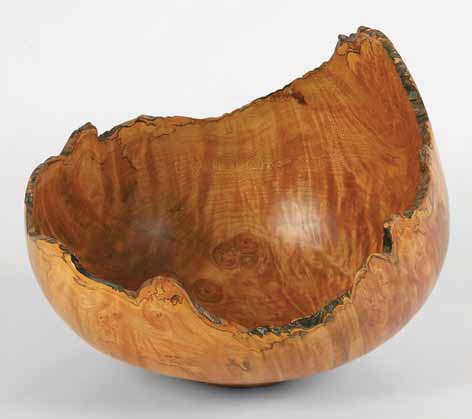 |
1970s: Natural edge bowl by Rude Osolnik
|
| |
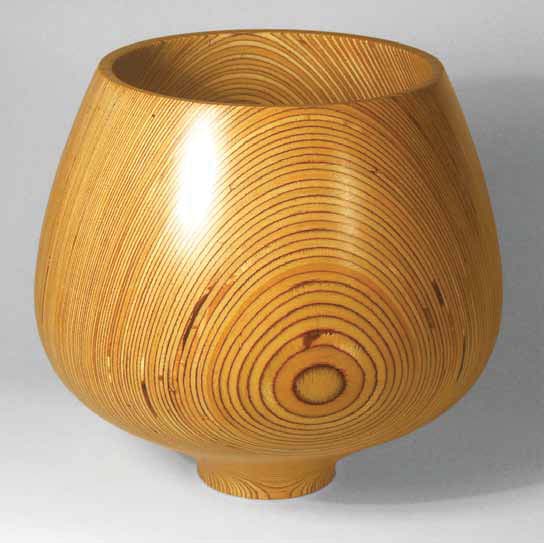 |
1970s: In company with other industrial designers, Rude Osolnik explored
the possibilities in manufactured materials such as plywood, here glued
together to create the blank for a bowl made of many layers of wood.
|
| |
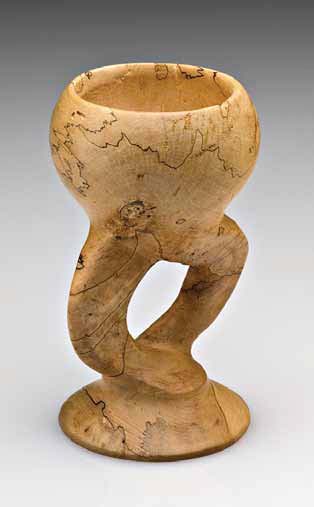 |
Melvin Lindquist: Carved chalice, 1977, spalted maple, photo by John McFadden/Lindquist Studios.
|
| |
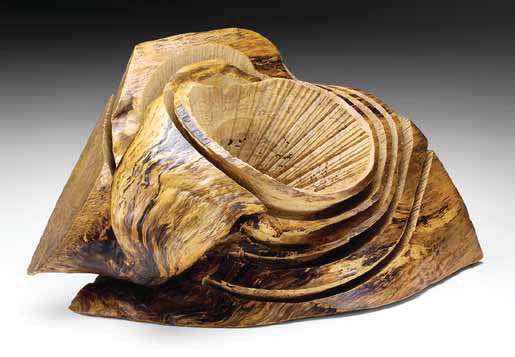 |
1950–1970: Melvin Lindquist discovered that he could turn bowls and vases from wood that everyone else deemed worthless. He popularized ‘spalted’ wood from downed trees where fungi have overlaid the natural figure with a network of fine black lines, almost as if drawn in ink.
|
| |
|
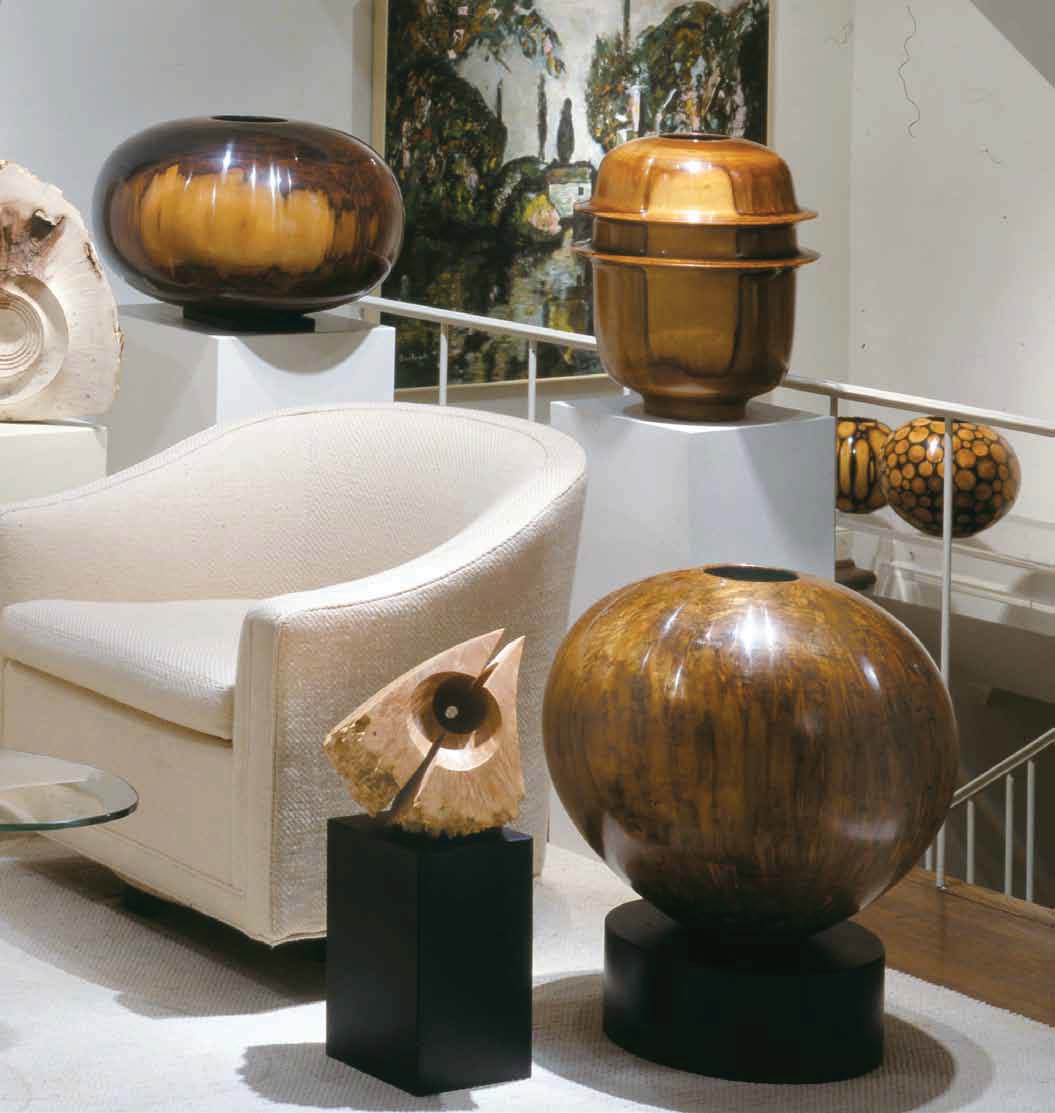
|
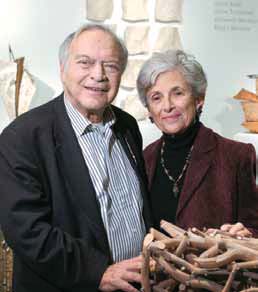 |
Living with Wood Art
1970s: Ed Moulthrop, an architect in Atlanta, perfected a process for replacing the water in fresh sawn wood with a waxy chemical called polyethylene glycol. This permitted him to turn hollow wooden forms of unprecedented size that did not crack and break. The orbs flanking the chair are by Ed Moulthrop and his son Philip: the three forms in the background were made by Philip. The angular turning in the left foreground is by Stoney Lamar. This is the living room of Arthur and Jane Mason, major collectors of turned wood art and leading members of the Collectors of Wood Art, and AAW honorary lifetime members, 2005.
|
| |
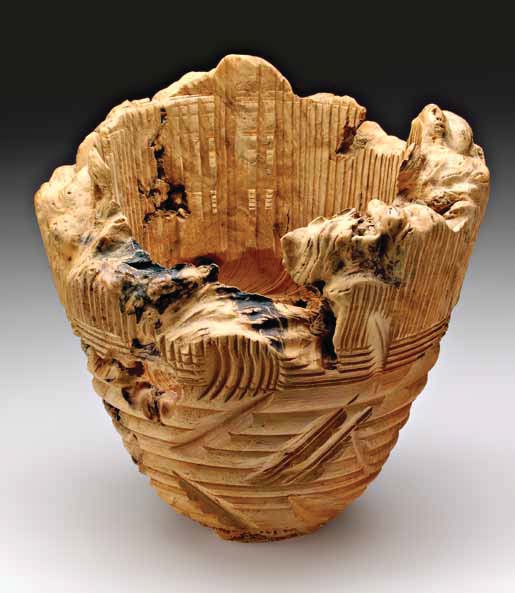 |
1980s: Unsung Bowl Ascending #3 by Mark Lindquist, spalted maple burl, 17" High. Mark combined the lathe with the chain saw, creating expressive, rough-hewn turned sculpture that won acceptance in the downtown “art” world.
|
| |
|
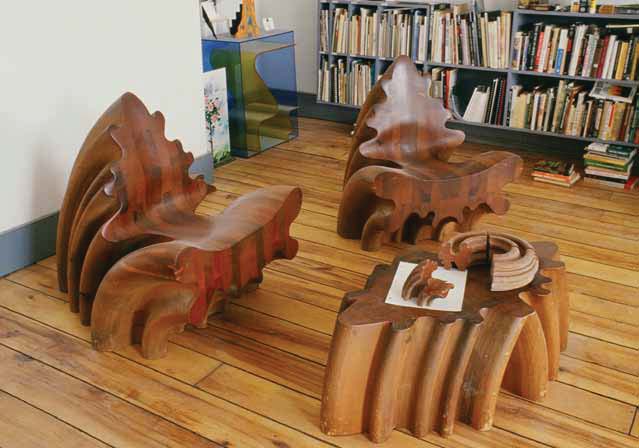
|
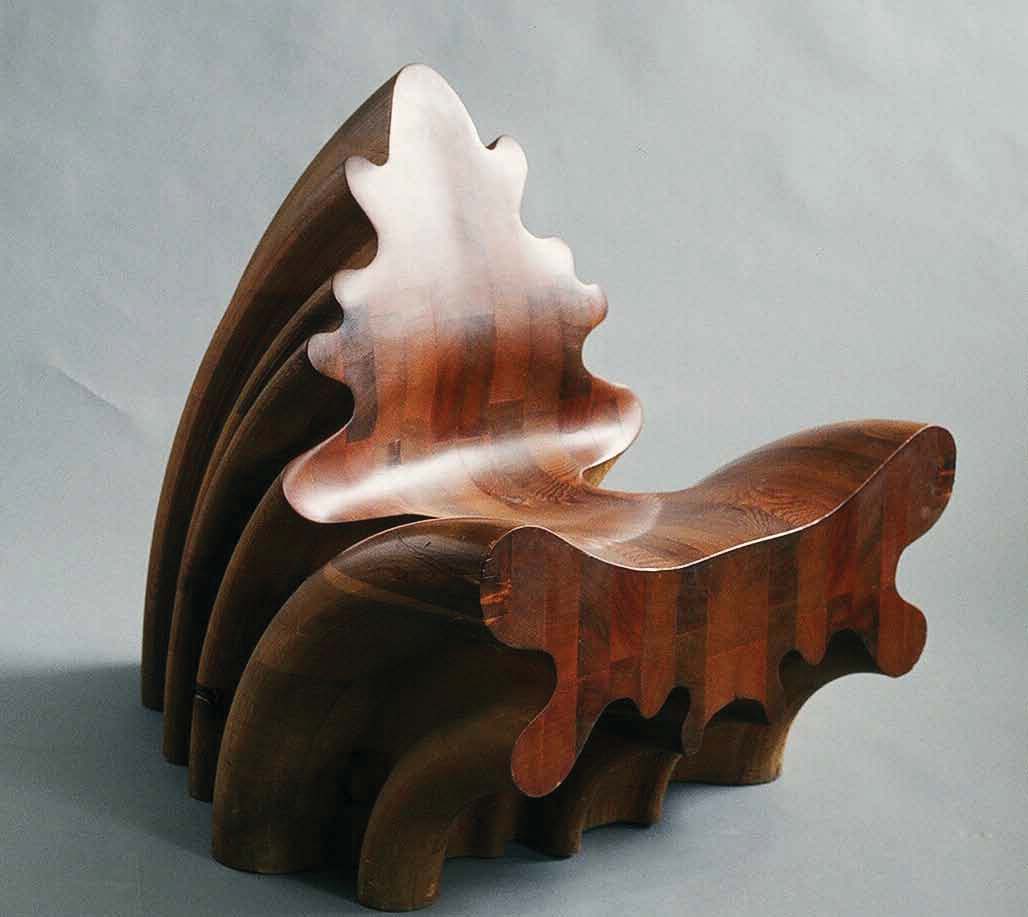 |
1974: Cedar Chair by Stephen Hogbin, from a suite of two chairs, and a table made from a single 76" dia. turning, cut and reassembled. Chair, collection of Yale University Art Gallery; chair and table, collection of Minneapolis Institute for the Arts. Stephen Hogbin demonstrated the lathe’s capacity to produce visually intriguing parts that could be cut apart and recombined into unexpected forms, such as these full-sized chairs with table, sawn and reassembled from a single turned disk of red cedar.
|
| |
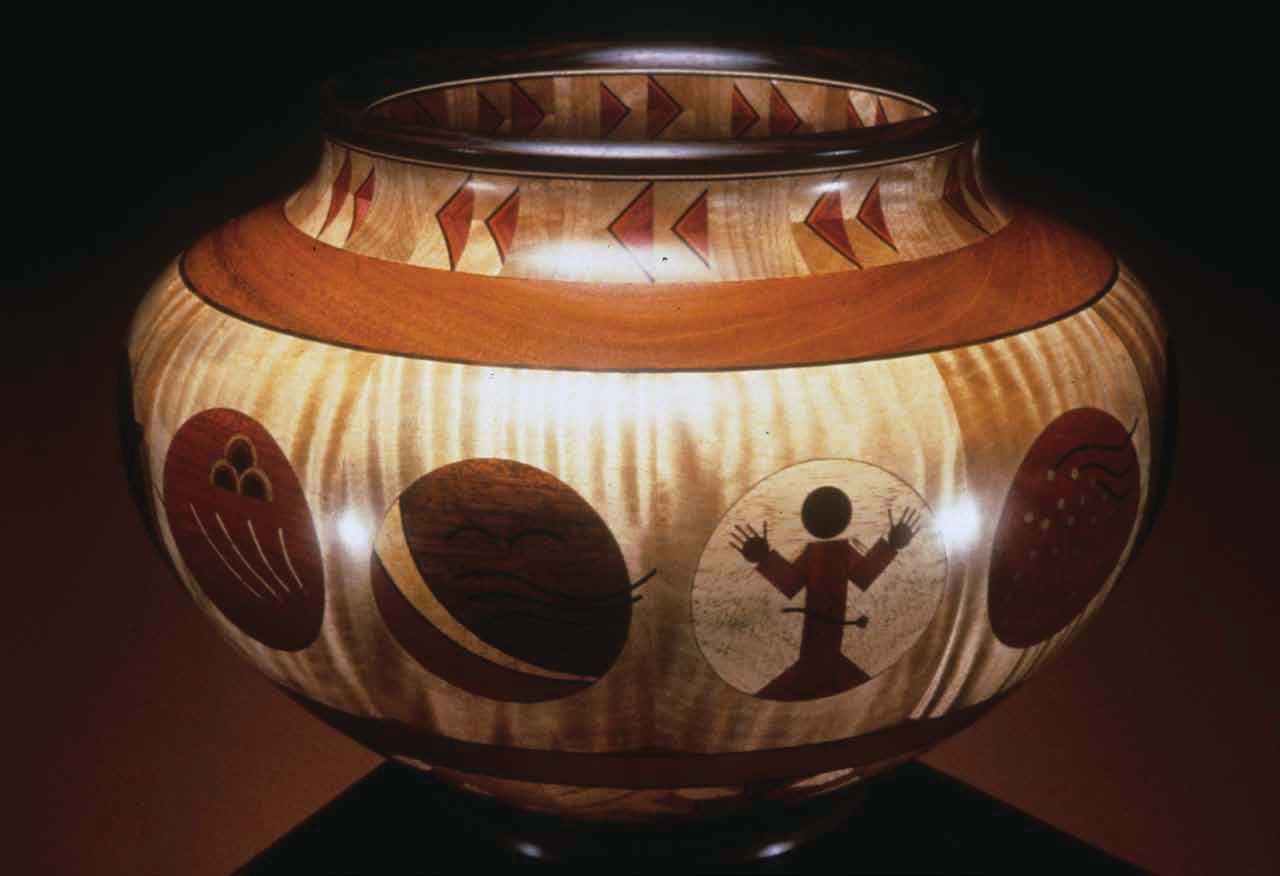 |
1980s: Giles Gilson perfected the intricacies of pictorial inlay in turned work, and went on to craft a large body of sculpture that featured finely wrought wooden surfaces alongside the glowing colors of automobile lacquer.
|
| |
|
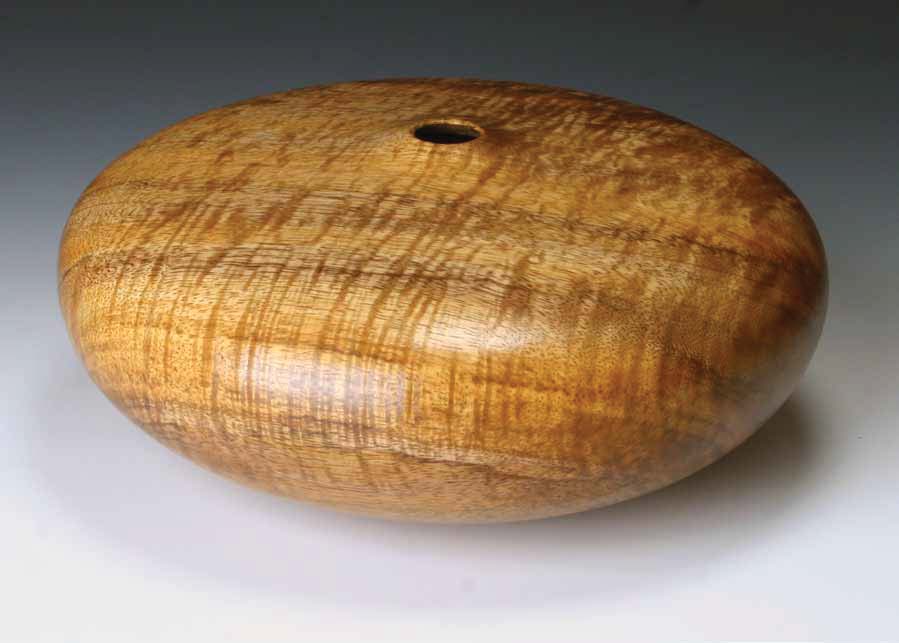
|
.jpg) |
1980s: David Ellsworth was first to solve the problem of hollowing a form through a tiny opening. This technique allowed him to work with wild figure of highly distressed wood.
|
| |
|
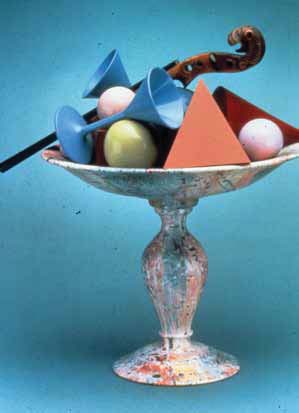
|
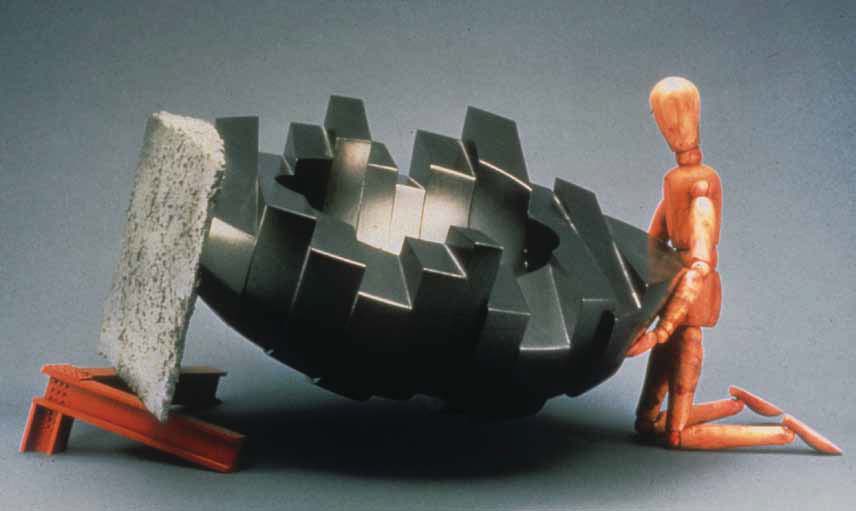 |
1986: Hap Sakwa was among the first woodturners to forsake craft and devote his attention to “art.” He later became a photographer.
|
| |
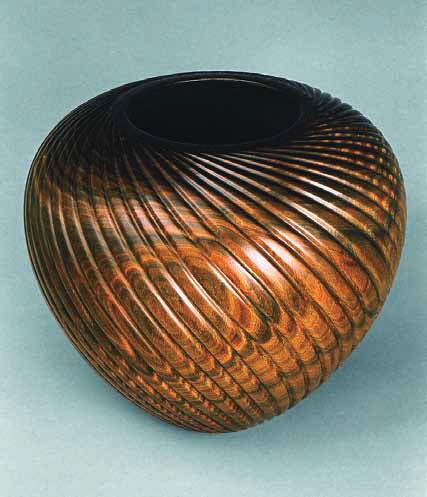 |
1988: Flutes in Palo Santo, by William Hunter, 10" dia. Photo by Barry Blau.
|
| |
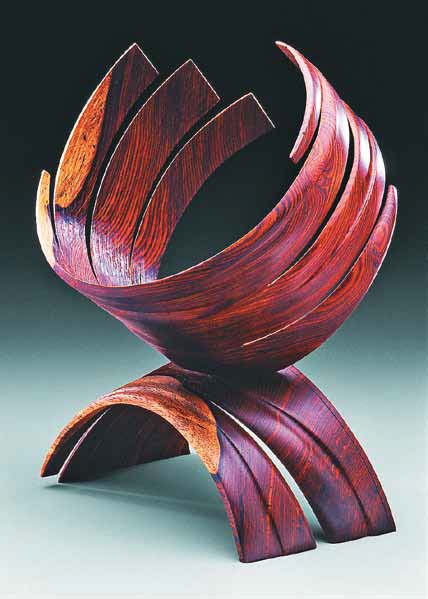 |
1997: Flying Loose, by William Hunter, cocobolo, 10" high. Photo by George Post.
|
| |
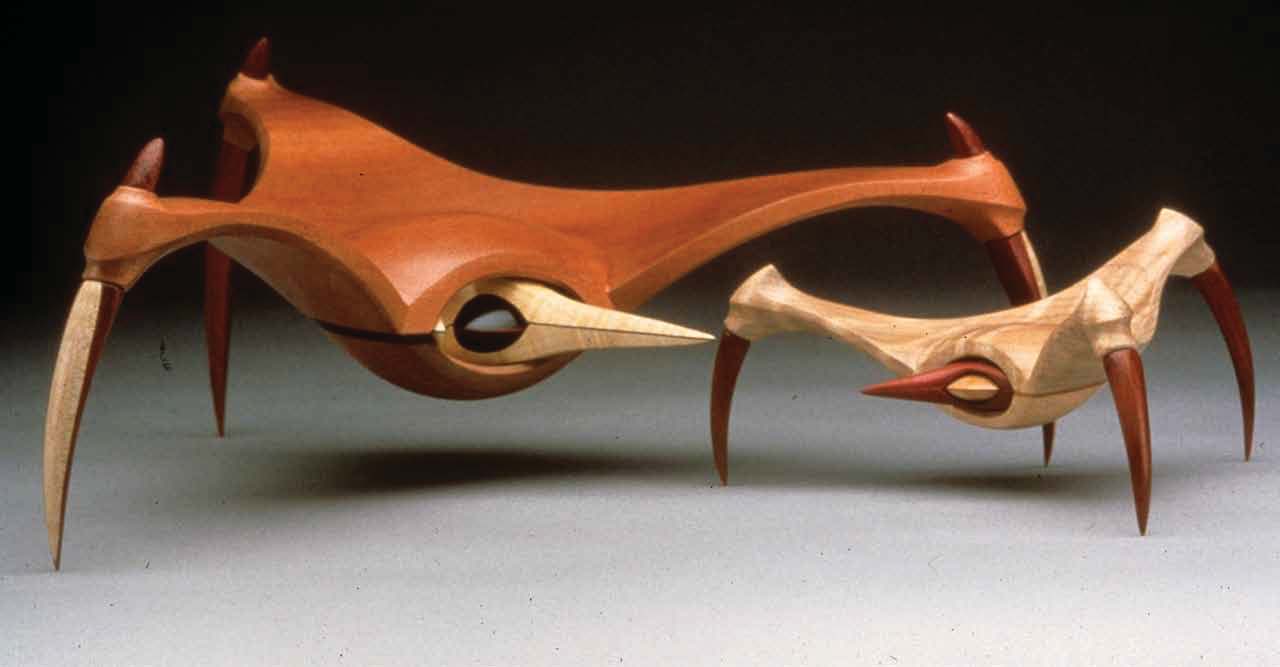 |
1992: Mother/Daughter, Hunter/Prey 11, by Michael Brolly, mahogany, maple, bubinga and ebony, 13" wide and 6" wide, the Lipton Collection. Photo by David Haas. Michael Brolly, building on Stephen Hogbin’s work, discovered that he could create startling images by turning and sawing into wooden forms, then recombining the pieces.
|
At the beginning of the 20th century, the lathe was perhaps the last thing to be considered a tool for creating a bold new art form. Modern art was defined by experiments in painting and sculpture, not utility. Lathe work concerned woodworking and craft—worlds away from new art movements such as abstract expressionism and conceptualism. At the same time, the Arts & Crafts Movement had created a romantic and idealistic view of the craftsperson, in opposition to the “soulless” machine production of the Industrial Revolution. The lathe was a machine closely tied to industry and showed no promise as a means of self-expression. Despite these challenges, artistic woodturning grew organically out of the woodworking traditions and the cultural milieu of the 20th century.
Today artistic woodturning is an international phenomenon. While almost every country had some form of woodturning tradition, its exploration as a means of self-expression can largely be traced to artists working in North America. The apprentice system that had been established in Europe had initially flourished in the United States, though everyone worked with wood to some extent in the pioneering years. Perhaps due to the independent spirit of this new nation, within a century of its founding, traditional apprenticeships were in decline. To fill the void, industrial arts education increasingly became part of every high school education, as experience with tools and machines such as the lathe were vital in educating workers who could develop careers in engineering, design, or factory work.
Pioneers
Woodturning hobbyists emerged largely from the period of prosperity that followed World War II, which led to the production of low-cost lathes with instructional books and magazines. Finding it an agreeable pastime, individuals across the country, who had initially been exposed to the lathe in high school, began creating functional objects at home. Among these individuals were the pioneering artists in the field of artistic woodturning.
The journies of five artists—James Prestini, Bob Stocksdale, Melvin Lindquist, Rude Osolnik and Ed Moulthrop—illustrate the currents leading to development of the field of artistic woodturning.
James Prestini
James Prestini’s exploration of woodturning was directly influenced by the wave of European artists, architects and craftsmen who moved to the US during World War II. Among these were the founders of Germany’s Bauhaus, a school that sought to unify art, craft and technology. Unlike the proponents of the Arts & Crafts Movement, these individuals viewed the machine in a positive light and industrial design and product development were pursued. The New Bauhaus was established in Chicago and it was here that Prestini came to know and be influenced by Mies van der Rohe, Laszlo Moholy-Nagy and Herbert Bayer. Though these individuals were often at odds with each other, they all embraced the Bauhaus aesthetic of accomplishing the most with the least—an approach that Prestini took to heart in turning wood bowls.
Prestini’s exploration of woodturning was short lived, from 1933 to 1953, while also creating sculptural work in wood, and before moving to other mediums including marble and metal. Nevertheless he set a standard for excellence in woodturning and, with the presentation of his work in a major exhibition at the Museum of Modern Art in 1949, established the validity of the wood bowl as an art object.
Bob Stocksdale
World War II impacted Bob Stocksdale’s life differently. Following the bombing of Pearl Harbor, he was drafted. In an environment of fervent patriotism, Stocksdale chose to be conscientious objector and was sent to work at a camp in Michigan under the auspices of the United States Forest Service. After the Forest Service learned that he was a woodworker, he was taken to Forest Service headquarters and shown what he later described as “the most beautiful wood-working shop that you could imagine, with all kinds of tools and everything, and nobody to run them.”
Stocksdale was put in charge of the facility and one day tried turning a bowl on the lathe. The results led him to make more and he eventually began to market bowls through a small shop in Ohio, being given only the condition that he “keep up the quality.” Ultimately, Stocksdale created a new approach to woodturning by simply replacing the glaze of ceramic tea bowls from Japan and other Asian countries with the pattern and figure of wood. The path of anti-war sentiments leading to a life as a woodturner would ultimately play out among the next generation of pioneering woodturners.
Along with his unerring eye for form and wood figure, Bob Stocksdale was first to perfect the method of retaining the natural surface of the log as the rim of his turned bowl. This required perfectly sharp tools, and impeccable technique.
Rude Osolnik
Rude Osolnik began his career teaching at Berea College in Kentucky, which offered students from the Appalachian region a unique work program. The school’s first work/study program was established in 1896, born out of the recognition of the quality of regional handcrafts that reflected the traditions of early European settlers. While teaching at the college and overseeing its woodshop, Osolnik began to create turned wood objects as a means of earning extra money, before serving as an officer in the Navy following the outbreak of World War II.
Returning home, Osolnik continued to expand the industrial arts program at the school, while creating turned wood pieces on the side. He became active in the Southern Highland Handicrafts Guild, selling work in the Guild’s craft fairs and in local shops. Soon, "Osolnik Originals" was a successful cottage industry, bearing the influence of Appalachian crafts and Scandinavian design.
Mel Lindquist
Mel Lindquist began turning wood as a child, using an old lathe on the family farm, and in high school continued to explore the lathe in wood shop class. The war years were spent as a surveyor for the military in Alaska, where he developed a passion for the natural world, leading him to purchase 100 acres of land in the Adirondacks. It was here that he came to have a deep love of wood in its natural state—seeing the natural beauty in the diseased and storm-damaged trees he cut down on his land. With an approach worthy of the American Transcendentalists, he viewed the wood he salvaged as a gift from the forest.
Getting his degree as an aeronautical engineer, Mel went to work as a master machinist for General Electric, operating a vertical turret lathe. Becoming quality control manager for the company, Lindquist’s days were spent making sure that tolerances were kept within a few thousandths of an inch. To unwind, he enjoyed turning wood in the evening, which allowed him absolute creative freedom. Yet, seeing the beauty in the spalted wood he found on his property led him to draw upon his experience in engineering and machining to develop carbon-tipped tools and techniques for blind boring. It was in this manner that the field of artistic woodturning has grown ever since, simultaneously expanding on both the aesthetic and technical fronts.
Ed Moulthrop
Ed Moulthrop was eight years old when he came across a magazine advertisement for a lathe. He took a job delivering newspapers and magazines to earn the $18 dollars it cost, and over the next several years created small objects he gave to family members as Christmas presents. Following in his father’s footsteps, Moulthrop became an architect, as woodturning showed little potential as a means of making a living.
“In those days… I think the crafts like woodturning and woodworking furniture weren’t well known,” he later recalled. “In fact, I think in the early 30s… America was in a rejection period of handmade things.”
While teaching architecture at the Georgia Institute of Technology, Moulthrop began using the school’s industrial arts shop, and eventually built a small shed on the side of the shop, to explore woodturning. An article in Popular Mechanics on the military’s use of polyethylene glycol to stabilize wood led him to experiment with the material, which allowed him to turn large forms that worked well in interior design. Architects including Moulthrop’s hero Frank Lloyd Wright and Arts & Crafts era architects Greene & Greene had promoted the importance of the objects that fit into their homes. This influence led Moulthrop to create work with a conscious exploration of space and placement.
Studio Movement
The stories of these five woodturners reflect the currents that shaped the field during these pivotal years: the impact of World War II on the individuals and the influx of artists from Europe, a modernist embrace of the machine in creating work, the legacy of the Arts & Crafts movement, the impact of Asian design, folk craft traditions handed down by early settlers, industrial arts, craft guilds, Scandinavian design, engineering, publications such as Popular Mechanics and architecture. It was all thrown into the mix during a period of economic recovery following the war when individuals sought out their destinies in an ever-changing landscape where any path could show promise.
Of course, woodworking was just one of many material disciplines redefining itself. What has become known as the American studio craft movement grew out of earlier European craft movements, indigenous arts,and ritual objects. Prior to the Industrial Revolution, craft objects had been part of daily life. Following it, artists working in craft media worked in reaction, either by offering an antidote to mass-produced objects or by commenting upon modern life.
During the Great Depression, the federal Works Progress Administration and the GI Bill allowed crafts to flourish at the local and national level. Following the war, the US experienced an economic boom that made it possible for individuals to pursue the life of an independent craftsperson, working as designer-makers and building cottage industries. When Bob Stocksdale and Rude Osolnik began their careers as woodturners, they did so with the intention of making a living, as did hundreds of potters, metalsmiths and others in the postwar environment. Artists from the Bauhaus and other European disciplines taught craft processes at the School of Design in Chicago, Black Mountain College in North Carolina, Cranbrook Academy of Art in Michigan and other schools across the country. In retrospect, it’s of interest to note that Germany and Japan, the countries defeated in World War II, were the greatest aesthetic influences in the emerging field of contemporary craft. In 1968, the Beatles released yet another hit single, the words echoing the spirit of the time: “You say you want a revolution—well, you know, we all want to change the world.” The first generation of creative woodturners had developed markets for their functional work, having no idea that the revolution of the lathe would soon provide a means of challenging the status quo and living for a new generation. The Vietnam War had driven individuals to rethink and reinvent contemporary culture. The ensuing ‘back to the earth’ movement led many to consider traditional craft media such as clay, metal and wood as a means to live life as they chose. Yet, the spirit of the work was changing.
Mark Lindquist grew up with the lathe, watching and learning from his father, Melvin. In the late 1960s, Mark studied art at a small New Hampshire college and completed a two-year apprenticeship to a Zen potter. “In late 1960s New Hampshire,” he recalls, “opposition to the war and disillusionment with what society viewed as ‘progress’ led to professors leaving the establishment and going to live in the mountains, kids from the city going into farming, and people eking out a living selling useful items they made with their own hands. There was honesty in growing your own food and making things yourself, and the craft movement grew out of this environment. It was also a time of seeking for deeper meaning in simple activities and objects. I began applying the Zen ideals I learned as a potter’s apprentice to the woodturning I learned as a child, and turning away from the time-honored traditions of woodturning, I set out to create a market for wooden vessels as art.”
Stephen Hogbin saw a relationship between the two wars and the impact on artists working in craft media: “The second World War had a similar impact on the USA and people like Jackson Pollock expressed a new freedom of approach. Soon after, Peter Volkous punctured the plate in a similarly violent and confrontational manner. Yet, the turners like Prestini and Stocksdale had continued to politely make their wonderful bowls in an Arts and Crafts manner.”
As a young designer living in London, Hogbin experienced Carnaby Street in full swing as the spirit of the sixties transformed the environment. He viewed the conservative nature of design in relationship to the previous generation’s experiences.
“My training started in the 1950s and a number of my instructors had experienced the Second World War,” Hogbin says. “There is no doubt that war takes a huge toll on the individual and how they see the world. They looked for order in the chaos and felt a responsibility to articulate the need for the designer to bring a new vision. It was very moving to watch their struggle with intentions and creativity. In the late ‘60s, there was a revolutionary air in the arts. Expressionism was giving way to conceptualism. The captains of industry were leading the way into a cynical world or a place where every one could afford good design.”
Giles Gilson saw something else in the concerns of the previous generation: “I grew up hearing my father and his friends complain that things weren’t as good as they used to be… that things weren’t as well made. My father would point out one of the new cars and talk about design flaws or how a part wasn’t fitted properly. Later, in my studies of both the arts and industrial design I learned the how and why of quality.”
David Ellsworth puts it this way: “What probably characterized this era for creative persons like myself was a sense of personal empowerment that emerged from the political and cultural turmoil of the ‘60s. Making money, owning property and cultivating a future were not our primary objectives. The concept of ‘retirement’ was so foreign and remote that only our parents could appreciate our lack of foresight. That said, those of us who pursued our art with the intensity that I had engaged probably thought, as I did, that 18-hour days were commonplace. We played all the roles, including acquiring raw materials, learning techniques, the skills of advertising, photography and marketing, traveling to exhibitions, bookkeeping, taxes, boxing and shipping, writing articles, giving lectures…any and all elements to further expose, promote, and distribute our artwork. Most of all, we became part of a very supportive community of wonderfully creative people, all of whom were entrepreneurs in their own right, and all living on the edge. It was a vital time with vital people.”
William Hunter graduated from Santa Monica City College with an associate arts degree in fire science in 1968, passed the exams to become a firefighter, and was called to begin training. However, this career path would not protect him from the draft and being sent to fight in Vietnam. He considered joining the Navy reserve, but his mind was made up after discussing his options with a college professor. He would continue his college education and take a deferment, leaving the option to go into firefighting open.
While studying philosophy and sociology at California State University Dominguez Hills, he began working in wood with a couple of friends, eventually creating and selling their wares at local craft shows. He and his friend Harvey Holland named their endeavor the “Global Village Wood Shop,” inspired by Marshall McLuhan’s vision of the world becoming one unified village with a free exchange of ideas.
As part of the new counter-culture movement, Hunter embraced independence, protested the Vietnam War and promoted social change. Being an artist allowed him to operate outside the norms of society, take charge of his life and avoid being part of corporate culture. To realize this vision of a contemplative and self-sufficient life, one guided by a deeper commitment to self-exploration and expression, Hunter and his friends began to search California for a rural property they could buy and settle on. This led him to settle on a piece of land near Yosemite National Park, where he ultimately built his home and studio, and established himself as a wood artist.
Pragmatic Idealism
In the 1970s the idealism of the late 1960s became increasingly pragmatic.
“Many of the post-World War II artists formed strong university art departments and some, like Alfred University, the College of Arts & Craft in Oakland, the Kansas City Art Institute and the School of American Craftsman at R.I.T. developed programs where crafts were taught,” David Ellsworth recalls. “Private craft schools like Archie Brae, Black Mountain, Penland, Haystack, Arrowmont and the Anderson Ranch gained strength by picking up teachers from both university and private studios. These schools became the training ground for a new generation of artists working in a craft medium.”
As bigger and better organized craft fairs began appearing across the continent, craftspeople maintained a simple approach to display and selling, and many looked on the concept of “marketing” as being part of “the establishment” they were rebelling against.
Mel Lindquist had been creating bowls and vases out of spalted wood for over a decade, though he marketed his work only locally. In the late ‘60s, at his son Mark’s urging, he had begun to exhibit at craft fairs, and when Mark began creating work to sell in 1971, the two looked to regional craft fairs, especially the Rhinebeck craft fairs, which offered an upscale clientele, and to galleries in the Northeast and New York City. In the midst of the rustic simplicity of the craft fairs of the time, Mark created booths that were small galleries, complete with track lighting and sculpture stands. His presentation of the work, as well as his nontraditional approach to woodturning, showing bowls with irregular grain, natural edges and flaws, opened a new market for woodturning, culminating in the accession in 1978 of two of Mark’s pieces and two of Mel’s by the Metropolitan Museum of Art in New York City. This pioneering work by Mark Lindquist certainly can be seen in retrospect as the “big bang” for the field of woodturning which had previously seemed to lie dormant in the woodshops of high schools throughout the country with little to no market existing for serious artistic wood turnings.
“Rhinebeck was important because it was close to New York City and they would get curators, department store buyers and Madison Avenue people,” Lindquist recalls. “The New York Times began covering ‘serious work’ in galleries exhibiting work in craft media, including The Elements, Fairtree Gallery and Florence Duhl.”
As Ellsworth explains: “The craft shows - particularly the Renaissance craft shows in California, the Pacific States Show in San Francisco and the Stowe, Vermont, craft show (which later become the Northeast Craft Show at Rhinebeck, NY), both sponsored by the American Craft Enterprises, the marketing entity of the American Craft Council—became the marketplace for crafts by offering direct public sales and a resource for galleries to view and stock up on new work by established and emerging artists. Craft, and the Movement of Modern Craft was in full swing when I came into the field.”
“During the mid 1970s, the streets of Southern California were lined on weekends with aspiring young crafters choosing an alternative and creative means to make their way in the world,” recalls Hap Sakwa, who was supporting himself by creating small bud vases and bowls. “Handmade houses, granola, tofu, bell-bottoms, Buddhism and The Whole Earth Catalog were a lot more appealing than, say, suburban ideals promoted at the time.”
“During the early 70s I was broke and decided that I wanted to make stuff,” Giles Gilson says. “We were all finding ourselves and looking for freedom. We didn’t want to go to work for someone else. Some of the people who went on to become leading figures in the field made pipes and other items for sale in head shops. I made weed pots and honey dippers. True freedom was being able to do things for yourself, even if it was humble. In the 70s a woodturner was a woodworker… thought of as a carpenter. There wasn’t a separate category. But when the craft fairs started and Jimmy Carter was elected and his vice president’s wife, Joan Mondale was interested in handmade crafts, it brought an amount of validity to what we were doing.”
“I left London England to teach in Canada,” Stephen Hogbin recalls. “The Vietnam War was taking its toll and Americans were moving to Canada… some to study crafts at the newly formed Sheridan College. The students had a huge impact on my life because they had confronted the big questions in their lives about what is right and wrong.”
One of the artists who impressed Hogbin was a young woodturner named Michael Brolly.
“He was interested in the idea of fragmentation and took the concept in a totally different direction to what had interested me,” Hogbin recalls. “I was interested in deconstructionism but that was a concept coming from architecture and unfamiliar to Michael, whose interest in ‘other world images’ seemed significant.”
Michael Brolly says, “I did not plan on going to college. I wanted to be a really great carpenter like my favorite uncle. Since I was not signed up for either college or the Army in my senior year of high school I had to take a test to see where I stood with all of the other graduating seniors that year and I scored in the top 2 percentile. The government sent around evaluators to try to guide us into what they deemed the proper slots. It was right after the Tet Offensive in Vietnam. The evaluator freaked out when he saw my scores and said, ‘You have to go to college, they are going to make cannon fodder out of you. There is a war going on out there, you will be drafted before the end of summer’. He said, ‘I’ll get you in college’ and he did. I went to Philadelphia Community College and got to take a couple of introductory art classes there, I was self-taught up till then.”
Brolly went on to study art at Kutztown University and to expand the language of artistic woodturning with his unique approach to the field.
As the 1970s segued into the 80s, the new breed of woodturners, exhibiting alongside Stocksdale, Osolnik, and Moulthrop in the emerging craft galleries, took a hands-on approach to both their careers and the field itself.
“Our goal was not only to sell the work for our own personal survival, but more importantly to legitimize our craft in the eyes of the art hierarchy that included galleries, collectors, museums and critics,” David Ellsworth says. “It was this challenge that led to the struggle in understanding the balance between traditional and contemporary crafts and, of course, the ongoing debate between Art and Craft. I saw my personal role during this period as both maker and teacher, each sharing the responsibility to ‘do good work.' My early involvement in teaching was a natural avenue for me, and it allowed me to help expand a greater awareness of my work to a much broader audience and, therefore, help legitimize the entire field of woodturning as it continued to grow. At that time, my feelings were that to have more and more people doing good work in woodturning meant that all of our standards would rise, and that our individual efforts would eventually broaden into a representative ‘field’ not unlike ceramics, glass, metals and jewelry. I feel that the formation of the American Association of Woodturners has proven those early projections to be correct.”
Kevin Wallace writes frequently on wood art and contemporary craft. He is director of the Beatrice Woods Arts Center in Ojai, California.
Footnotes
-
Oral history interview with Bob Stocksdale, 2001 February 16 - March 21, Archives of American Art, Smithsonian Institution.
-
Oral history interview with Ed Moulthrop, 2001 April 2-3, Archives of American Art, Smithsonian Institution.